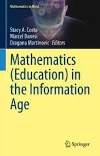- About MAA
- Membership
- MAA Publications
- Periodicals
- Blogs
- MAA Book Series
- MAA Press (an imprint of the AMS)
- MAA Notes
- MAA Reviews
- Mathematical Communication
- Information for Libraries
- Author Resources
- Advertise with MAA
- Meetings
- Competitions
- Programs
- Communities
- MAA Sections
- SIGMAA
- MAA Connect
- Students
- MAA Awards
- Awards Booklets
- Writing Awards
- Teaching Awards
- Service Awards
- Research Awards
- Lecture Awards
- Putnam Competition Individual and Team Winners
- D. E. Shaw Group AMC 8 Awards & Certificates
- Maryam Mirzakhani AMC 10 A Awards & Certificates
- Two Sigma AMC 10 B Awards & Certificates
- Jane Street AMC 12 A Awards & Certificates
- Akamai AMC 12 B Awards & Certificates
- High School Teachers
- News
You are here
Mathematics (Education) in the Information Age

Publisher:
Springer
Publication Date:
2020
Number of Pages:
236
Format:
Hardcover
Series:
Mathematics in Mind
Price:
109.99
ISBN:
978-3-030-59176-2
Category:
Collection
[Reviewed by , on ]
Peter Olszewski
08/13/2021
With the ever-evolving world around us and the rapid increase of Artificial Intelligence, Mathematics (Education) in the Information Age is a collection of 13 research papers that explore how mathematics should be taught to a generation grounded in the Information Age. This book examines the assumption that human intelligence may not be unique and how the role of technology in human evolution is critical in the 21st century. Regardless of what part of the globe, culture, or economic status a student is from, the Information Age applies to all of us and we as educators need to think about how to best teach our 21st-century students. The collection of research projects presented were conducted at the Fields Institute for Research in Mathematical Sciences with the goal to investigate mathematics from different theoretical and practical ways and how mathematics is learned and practiced in the Information Age.
In the opening chapter, The Information Age, Mathematics, and Mathematics Education, the argument is made that over time, mathematical texts have had to adjust how material is presented given the specific generation. One of the major topics that Costa, Danesi, and Martinovic discuss is Crowdsource Mathematics with the PolyMath Project, which envisions mathematics as a social practice. As pointed out on page 3, The Information Age has developed from three main perspectives (Pease et al. 2020):
- individual versus collaborative;
- connected intelligence; and
- human-computer interactions.
With the Internet, mathematicians can have further and easily attainable collaborations than in any previous generation and with computer science, programs such as the 1950s automated theorem proving (ATP) are incredibly innovative.
One of the most refreshing aspects of the book are the new theorems with proofs. For example, in chapter 2, An Unsupervised Approach to User Characterization in Online Learning and Social Platforms, Dan Vilenchik is addressing the task of characterizing students in e-learning platforms and how the data is similarly collected on users of online social networks (OSNs). Vilenchik goes on to discuss Principal Component Analysis (PCA) and semantic shattering with leads to the new Theorem 2.2 on page 31.
The encouraging results of elementary students showing high levels of mathematical thinking in chapter 3: Argumentation In Elementary: The Case for Teaching Argumentation in Elementary Mathematics Classrooms, by Krpan and Sahmbi shows how vital 21st-century skills and critical thinking are needed at a young age. On page 45, students in grades 2, 3, 4, and 5 were observed with no prior argumentation experience. Students need to make arguments as to why \( 10+10 \neq 12 \) and \( 6 \times 4 \neq 25 \).
The most exciting chapter for me was chapter 4, Subverting Stereotypes: Visual Rhetoric in the #SheCanSTEM Campaigns. This campaign is needed as, Ryan Noonan writes, “While women continue to make gains across the broader economy, they remain underrepresented in STEM jobs and among STEM degree holders.” Statistics to support this claim are presented on page 54. The book also has a paper on the cost of using a machine to do mathematics, chapter 9, where relying on technology too much to do computations can have an adverse affect on learning basic mathematics or worse yet, forgetting developmental mathematics. Chapter 12 by Metz and Davis, discusses the procedural, conceptual, and critical discernments for the evolution of school mathematics in the Information Age. On pages 208-209 and 211, bounding and naming differences is presented with pictures of How is 23 like/unlike \( 2 \times 3 \times 5 \)?, What Are Exponents?, Varying Problem Features, and Contrasting Relationships.
Each chapter provides a wealth of information with deep insight on how mathematics education and 21st-century teaching of mathematics to our students is quite different than even 10-20 years ago. I can clearly see how this collection of papers would be an interest to readers not only who are math educators, but also people who work with computer scientists or in computer industries. I highly recommend this book to anyone who wants to gain a robust and well-rounded experience in teaching the next generation in the Information Age.
Peter Olszewski, M.S., is a Mathematics Lecturer at The Pennsylvania State University, The Behrend College, an editor for Larson Texts, Inc. in Erie, PA, and is the 362nd Chapter Advisor of the Pennsylvania Alpha Beta Chapter of Pi Mu Epsilon. His Research fields are in mathematics education, Cayley Color Graphs, Markov Chains, and mathematical textbooks. He can be reached at pto2@psu.edu or www.personal.psu.edu/pto2. Outside of teaching and textbook editing, he enjoys playing golf, playing guitar and bass, reading, gardening, traveling, and painting landscapes.
See the publisher's website.
- Log in to post comments




